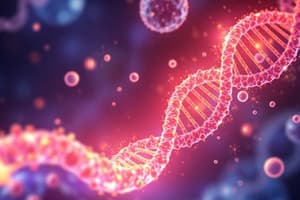Podcast
Questions and Answers
Which of the following cancers is NOT directly associated with radiation exposure?
Which of the following cancers is NOT directly associated with radiation exposure?
- Leukemia
- Gorlin syndrome (correct)
- Lung cancer
- Breast cancer
What is the main reason that normal cells in the radiation field cannot survive high doses of radiation?
What is the main reason that normal cells in the radiation field cannot survive high doses of radiation?
- They repair their DNA successfully
- They die as a result of being unable to divide (correct)
- They acquire mutations that inhibit cell division
- They become cancerous
In which tissue is sensitivity to radiation the highest?
In which tissue is sensitivity to radiation the highest?
- Thyroid gland
- Bone marrow (correct)
- Salivary glands
- Breast tissue
Which of the following events is linked to a significant increase in predicted cancer cases due to radiation exposure?
Which of the following events is linked to a significant increase in predicted cancer cases due to radiation exposure?
What cancer risk is increased in children after undergoing multiple CT scans?
What cancer risk is increased in children after undergoing multiple CT scans?
What is a potential consequence of DNA hypermethylation?
What is a potential consequence of DNA hypermethylation?
What role does the TET2 enzyme play in DNA methylation?
What role does the TET2 enzyme play in DNA methylation?
Which process is associated with histone acetylation?
Which process is associated with histone acetylation?
What is indicated by the correlation between the average number of stem cell divisions and cancer risk?
What is indicated by the correlation between the average number of stem cell divisions and cancer risk?
What percentage of CpGs are typically methylated in human adult cells?
What percentage of CpGs are typically methylated in human adult cells?
Which statement accurately describes the effects of post-translational histone modifications?
Which statement accurately describes the effects of post-translational histone modifications?
How can environmental exposures affect cancer cells?
How can environmental exposures affect cancer cells?
What is the implication of methylation as a physiologic mechanism in cells?
What is the implication of methylation as a physiologic mechanism in cells?
How much background radiation is equivalent to a Full Mouth series dental x-ray?
How much background radiation is equivalent to a Full Mouth series dental x-ray?
What is the estimated number of cancer cases caused by dental radiography annually in the US?
What is the estimated number of cancer cases caused by dental radiography annually in the US?
Which type of HPV is primarily responsible for cervical cancer?
Which type of HPV is primarily responsible for cervical cancer?
What mechanism allows high-risk HPV E7 to allow progression through the cell cycle?
What mechanism allows high-risk HPV E7 to allow progression through the cell cycle?
Which type of vaccine targets both HPV-16 and HPV-18?
Which type of vaccine targets both HPV-16 and HPV-18?
Which of the following viruses is associated with Burkitt lymphoma?
Which of the following viruses is associated with Burkitt lymphoma?
Which HPV types are classified as high-risk for cancer development?
Which HPV types are classified as high-risk for cancer development?
What cellular process does the EBV appear to enhance, contributing to cancer development?
What cellular process does the EBV appear to enhance, contributing to cancer development?
Which high-risk HPV protein promotes the degradation of p53?
Which high-risk HPV protein promotes the degradation of p53?
What reduces the incidence of cancer cases due to dental radiography?
What reduces the incidence of cancer cases due to dental radiography?
What are microRNAs primarily known for?
What are microRNAs primarily known for?
Which of the following best describes chemical carcinogens?
Which of the following best describes chemical carcinogens?
Which of the following is an example of an indirect-acting carcinogen?
Which of the following is an example of an indirect-acting carcinogen?
What is a characteristic mutation associated with aflatoxin B1 exposure?
What is a characteristic mutation associated with aflatoxin B1 exposure?
What distinguishes 'initiation' from 'promotion' in the context of chemical carcinogenesis?
What distinguishes 'initiation' from 'promotion' in the context of chemical carcinogenesis?
What are the characteristics of direct-acting carcinogens?
What are the characteristics of direct-acting carcinogens?
Which infectious agent is most commonly associated with hepatocellular carcinoma?
Which infectious agent is most commonly associated with hepatocellular carcinoma?
Which process is primarily responsible for the silencing of mRNA through microRNAs?
Which process is primarily responsible for the silencing of mRNA through microRNAs?
What condition is associated with chronic Helicobacter pylori infection?
What condition is associated with chronic Helicobacter pylori infection?
Which condition is most likely to increase the risk of mutations and hence cancer?
Which condition is most likely to increase the risk of mutations and hence cancer?
Which type of cancer is predominantly linked to immunodeficiency states?
Which type of cancer is predominantly linked to immunodeficiency states?
What is the role of the TP53 gene in cancer development?
What is the role of the TP53 gene in cancer development?
Which option correctly describes a role of Class I MHC molecules in immune surveillance?
Which option correctly describes a role of Class I MHC molecules in immune surveillance?
Chemical carcinogen-induced mutations are typically described as:
Chemical carcinogen-induced mutations are typically described as:
What effect does immunosuppression generally have on tumorigenesis?
What effect does immunosuppression generally have on tumorigenesis?
What type of cancer is associated with chronic inflammation due to an infection?
What type of cancer is associated with chronic inflammation due to an infection?
Which of the following is NOT considered an infectious agent implicated in carcinogenesis?
Which of the following is NOT considered an infectious agent implicated in carcinogenesis?
What is the primary consequence of ineffective immune surveillance in immunocompromised hosts?
What is the primary consequence of ineffective immune surveillance in immunocompromised hosts?
Study Notes
DNA Methylation and Demethylation
- DNA methylation can silence tumor suppressor genes without altering DNA sequence, leading to oncogenesis.
- DNA methylation can overexpress oncogenes without altering DNA sequence.
- CpG dinucleotides are common targets for methylation.
- TET2 enzyme plays a key role in demethylation and is more potent in hyperglycemia.
- There is a strong correlation between stem cell divisions per tissue and cancer rate in that tissue, largely due to methylation changes during cell division.
Post-Translational Histone Modifications
- Histone modifications regulate chromatin accessibility, influencing gene expression.
- Histone acetylation is associated with open chromatin and active gene expression.
- Histone methylation has diverse and complex effects on gene expression.
- Cancer cells often exhibit altered DNA methylation patterns and histone modifications, leading to aberrant gene expression.
MicroRNAs
- MicroRNAs are small RNA molecules (20-23 nucleotides) that regulate gene expression post-transcriptionally.
- MicroRNAs bind to complementary mRNA sequences, silencing mRNA molecules and inhibiting protein translation.
Chemical Carcinogenesis
- Chemical carcinogens can directly damage DNA or stimulate cell proliferation.
- Mutations caused by chemical carcinogens can give cells selective growth advantages, increasing malignancy risk.
- Cigarette smoke is a major cancer risk factor, leading to accelerated mutation rates and increased driver mutations.
- Some carcinogens target specific DNA sequences, creating mutation hotspots.
- Aflatoxin B1, a common food contaminant, increases hepatocellular carcinoma risk and is associated with p53 R249S mutation.
Chemical Carcinogens: Initiators and Promoters
- Initiators cause permanent and irreversible genetic changes, leading to cell initiation.
- Promoters enhance the proliferation of initiated cells but are reversible and not carcinogenic alone.
Chemical Carcinogens: Initiators (continued)
- All initiating carcinogens are electrophiles, attracting and mutating nucleophiles like DNA, RNA, and proteins.
- Direct-acting carcinogens are carcinogenic without metabolic conversion.
- Indirect-acting carcinogens require metabolic conversion to become carcinogenic.
Ionizing Radiation
- Ionizing radiation is carcinogenic, generating oxygen free radicals that damage DNA.
- Radiation therapy utilizes DNA damage to kill cancer cells.
- Radiation can also damage normal cells, contributing to side effects.
- Normal cells can acquire cancer-promoting DNA damage after radiation.
Radiation Carcinogenesis
- Different tissues have varying sensitivities to radiation.
- Bone marrow is highly sensitive, followed by the thyroid in young individuals.
- Breast, lungs, and salivary glands have intermediate sensitivity.
- Any cell can be transformed into a cancer cell with sufficient radiation exposure.
- CT scans increase leukemia and brain tumor risk in children.
Dental and Maxillofacial X-Rays
- Dental X-rays contribute to background radiation exposure.
- Proper selection criteria and collimation can significantly reduce radiation exposure.
- Estimated 1000 cancer cases annually are linked to dental radiography.
Microbial Carcinogenesis
- Only a few viruses and bacteria are potentially oncogenic.
Human Papillomavirus (HPV)
- HPV is a ubiquitous DNA virus with 120 identified types.
- HPV infects epithelial surfaces, causing various conditions including cervical cancer.
- Certain high-risk HPV types integrate into host DNA, leading to overexpression of E6/E7 proteins.
- High-risk HPV E6 degrades p53 and stimulates TERT, while HPV E7 inactivates Rb, allowing uncontrolled cell cycle progression.
Human Papillomavirus (HPV) (continued)
- HPV types are categorized based on carcinogenic potential, with high-risk types causing cervical and oropharyngeal cancers.
- HPV vaccines prevent infection and reduce cancer risk.
Epstein-Barr Virus (EBV)
- EBV is associated with several cancers, including Burkitt lymphoma, B-cell lymphomas, and nasopharyngeal carcinoma.
- EBV acts as a potent mitogen, promoting cell proliferation.
Hepatitis B and C Viruses (HBV, HCV)
- HBV and HCV cause 70-85% of worldwide hepatocellular carcinoma.
- The dominant oncogenic effect is chronic inflammation and liver regeneration, possibly immunologically mediated.
Helicobacter pylori
- Chronic H. pylori infection leads to antral gastritis and increased risk for ulcers, gastric adenocarcinoma, and MALT lymphoma.
- The chronic inflammatory state promotes a pro-carcinogenic environment.
Cancer and Immunosuppression
- Immunodeficiencies are associated with higher cancer frequency.
- Immunosuppressed individuals have decreased immune surveillance, allowing tumor cells to evade detection and destruction.
- The impaired immune system allows for favorable conditions for infection and tumorigenesis.
Cancer and Immunosuppression (continued)
- Class I MHC antigen processing pathway is crucial for immune surveillance.
- All nucleated cells express MHC I antigens, presenting self or foreign peptides.
- CD8+ T-cells bind to MHC I antigens, inducing apoptosis if abnormal peptides are detected.
Studying That Suits You
Use AI to generate personalized quizzes and flashcards to suit your learning preferences.
Related Documents
Description
Test your knowledge on DNA methylation, histone modifications, and microRNAs. Explore the mechanisms through which these molecular processes influence gene expression and cancer development. This quiz dives into the intricate roles of enzymatic actions and RNA molecules in cellular functions.




